Oxygen vacancy mediated TiO2-x-MoS2/FTO heterostructure as an efficient photoanode for photoelectrochemical water splitting
IF 5.9
3区 工程技术
Q1 CHEMISTRY, MULTIDISCIPLINARY
Journal of Industrial and Engineering Chemistry
Pub Date : 2024-11-28
DOI:10.1016/j.jiec.2024.11.043
引用次数: 0
Abstract
To achieve a complete water splitting cycle, solar-assisted oxidation plays a crucial role. Discovering efficient photoanodes capable of absorbing visible light is essential to enable cost-effective solar energy conversion. This study devised an efficient hydrothermal method to synthesize a TiO2-MoS2 heterostructure with an oxygen vacancy on FTO (fluorine-doped tin oxide). The structure, morphology, optical properties, and photoelectrocatalytic behavior of the TiO2-x-MoS2 heterostructure using various techniques. The oxygen vacancy state can create a new sublevel state below the conduction band of TiO2, which narrows the band gap to a lower level and thus extends the absorption edge into the visible region. The strategy of oxygen vacancy resulted in a photocurrent density of 0.6 mA cm-2, which is 3 times higher than pure TiO2. Also, the TiO2-x-MoS2 heterostructure exhibits a photocurrent density of 2.6 mA cm−2 and higher O2 evolution than pure TiO2 in a 1.0 M KOH solution under UV–Vis irradiation. Compared to unmodified TiO2 nanorods, TiO2-x-MoS2 electrodes exhibit an increase of 13 times in photoelectrochemical activity and have a low overpotential. This is due to accelerated electron transfer kinetics at the TiO2-x-MoS2 interface, an enhanced density of charge carriers, a reduced rate of charge recombination, and a highly wettable surface.

求助全文
约1分钟内获得全文
求助全文
来源期刊
CiteScore
10.40
自引率
6.60%
发文量
639
审稿时长
29 days
期刊介绍:
Journal of Industrial and Engineering Chemistry is published monthly in English by the Korean Society of Industrial and Engineering Chemistry. JIEC brings together multidisciplinary interests in one journal and is to disseminate information on all aspects of research and development in industrial and engineering chemistry. Contributions in the form of research articles, short communications, notes and reviews are considered for publication. The editors welcome original contributions that have not been and are not to be published elsewhere. Instruction to authors and a manuscript submissions form are printed at the end of each issue. Bulk reprints of individual articles can be ordered. This publication is partially supported by Korea Research Foundation and the Korean Federation of Science and Technology Societies.

 求助内容:
求助内容: 应助结果提醒方式:
应助结果提醒方式:


